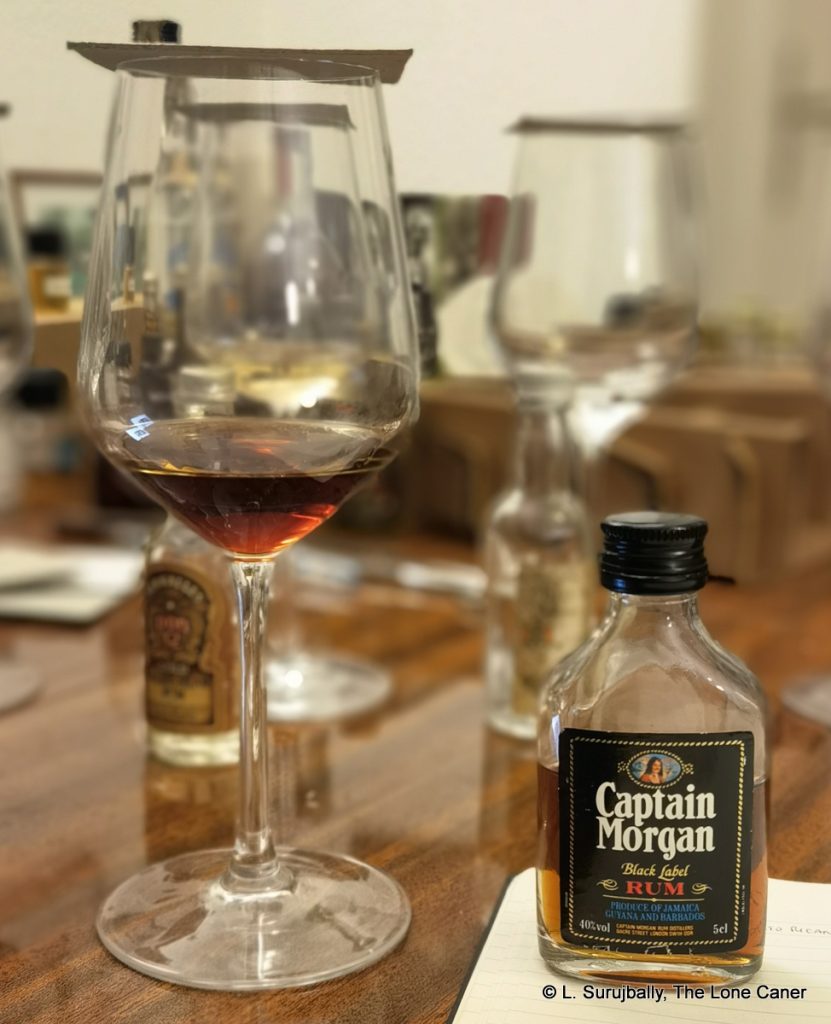Rumaniacs Review #140 | 0952
Captain Morgan, of course, requires no introduction, yet its history presented us with some interestingly convoluted pathways (R-139); it showed that although in its modern 2020s iteration it’s a throwaway piece of cheap spiced dreck, made with indifference and sold wholesale with what I can only conclude is contempt for its core audience, the fact is that once, not too far back, it had aspirations to being something quite a bit more interesting. More genuine. Almost a real rum.
We can date this one more accurately because the 70º on the label had been replaced with 40% ABV which went into effect in 1980, and since 1984 the “Original Spiced” came on the market so the blends were gradually (if not instantly) discontinued. This may be one of the last of the true multi-country blends, and in this case it looks like they were drawing down from all the casks they had in storage from Barbados, Jamaica, and Guyana.
Colour – Dark amber
Strength – 40%
Nose – Sweet stewed plums, cherries in syrup, Licorice, salt caramel, molasses, wood, pencils, tree bark and sap. A few fleshy fruits roaming around in the background, bananas, very ripe oranges, but too faint to make much of an impression.
Palate – Thick, sweet caramel and brown sugar dominate, with molasses, and a strong latte. Some apples, raisins, syrup and a few spices like cinnamon and nutmeg. It’s interesting and a far cry from the sort of thin pickings today’s spiced rums have become.
Finish – Short, to be expected. Mostly caramel, coffee, chocolate, licorice and some sawdust, with the slightest citrus hint cutting through.
Thoughts – This is why I like these old rums, and, even more, old rums that are the progenitors of today’s editions. No matter what the economic reasons that the rums of yesteryear were made the way they were, it’s obvious that even at the low strength at which they were issued back then, they were worlds apart, and better, than the modern variants with their crude sweetening and spicing: in comparison, the new “rums” are just ersatz products, pale imitations, and, in fine, dirty deeds done dirt cheap.
(78/100)
- The label states that it’s made by an outfit called Captain Morgan Rum Distillers in London (Dacre Street SW1H 0DR), which, as far as I can ascertain, is the distribution arm in the UK at that time, never mind that they didn’t have a distillery there. The street address is long closed and has been redeveloped into flats, a small hotel, and office space.
- Seagram’s and Vivendi merged in June 2000, with the key point being the joining of their media empires…the spirits business was secondary and Edgar Bronfman noted at the time it would be sold off anyway. A year later the wine and spirits division of Seagram’s was on the block and three conglomerates were in the running to take over the lucrative brand portfolio: an alliance of Brown-Forman and Bacardi, the latter of which at the time was having cash flow issues and was heavily in debt; Allied Domecq; and a partnership of Pernod-Ricard and Diageo. Diageo-PR won the tussle, split the portfolio and Diageo walked away with (among other brands) Captain Morgan, though they had to give up Malibu brand on anti-competitive grounds to do so.
- Distillation — aside from that derived from Long Pond, and other countries’ stocks — was primarily from Puerto Rico. Around 2011, Captain Morgan was induced by massive tax breaks and financial concessions, to build a distillery and make its rums in the US Virgin Islands. Nowadays this is where Captain Morgan brands are made.
- Originally, as noted, Captain Morgan was a blend from Jamaica and other islands. Hugh Barty-King and Anton Massel, in their 1983 book “Rum Yesterday and Today” (p.190), wrote that “There were always 65,000 forty-gallon barrels of rum at the Seagram UK processing plant at Speke, Liverpool, and the storage centre at Huyton. Their supplies came mainly from Guyana and Jamaica, but also in small amounts from Barbados, Hawaii, Mexico and Puerto Rico. The rum was diluted and made up into various blends, put into bottles on which labels were put with such names as ‘Captain Morgan’ (the most in demand), ‘Woods’, ‘Myers’, ‘Old Charlie’ and ‘Tropicana’.”


A really excellent review and one that shows appreciation for the classics! Thank you.